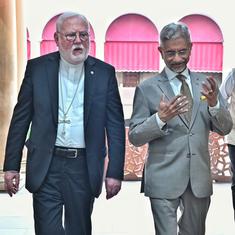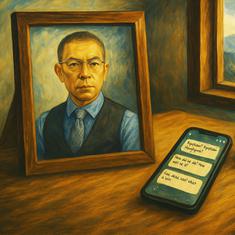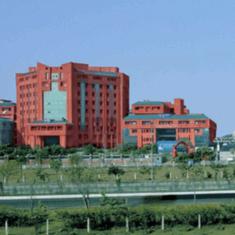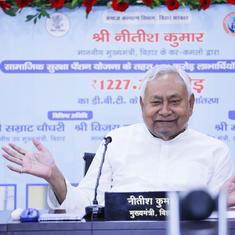Even as temperatures in Bengaluru reached 37.6 degrees celsius this April, many public parks and green spaces in the Garden City remain closed during the peak afternoon hours, depriving city dwellers, especially outdoor workers, of a space for refuge.
“My uniform is soaked in sweat, there is no place for us to drink water, eat our lunches or even sit for a moment in the shade,” said 40-year-old Bhima, who has been working as a pourakarmika, a municipal sanitation worker, for the past eight years. While he and his peers have worked through heat, rain spells and winter mornings, he said the last couple of months have been particularly harsh during his shift from 6 am to 12 pm.
Susheela N, a street vendor in Banashankari, vends in the partially-shaded part of a busy street, which she feels has a high footfall of customers. She works from 6 am till noon every day, then walks three kilometres home and returns at 4 pm for her evening sales. The park she vends next to is closed in the afternoon. “If the park was open, I would’ve had my lunch there, rested and continued vending from 3 pm,” she said.
Bengaluru has 1,020 developed parks, spanning almost four square kilometres, which fall under the jurisdiction of Bruhat Bengaluru Mahanagara Palike’s Horticulture department. According to Chandrashekhar MR, the deputy director (horticulture), the parks are shut between 10 am and 1.30 pm for maintenance. “During this time the pathways will be swept and cleaned, this activity cannot be undertaken at night,” he told Mongabay-India.
However, when Mongabay-India visited public parks in Banashankari and Jayanagar in the south Bengaluru and Vijayanagar in west Bengaluru in April, it found that most of the parks, except a few in Jayanagar, were closed even after 1.30 pm. The signboards on the locked gates had park opening hours to be until 10 am and after 5 pm, indicating the park was closed through most of the day when the temperatures were the highest.

Green cover to the rescue
Although Karnataka does not fall under Core Heatwave Zones, which includes the states most prone to heatwave, the India Meteorological Department issued a circular on April 4 warning that Karnataka will have heatwave-like conditions for the next few days.
Shortly after, Bengaluru recorded temperatures going up to 36.5 degrees celsius. While technically not amounting to a heat wave, the high temperatures deviated from the city’s mean daily maximum temperature of 34 degrees Celsius for April.
The high temperatures have a disproportionate impact on informal workers, particularly those who work outdoors. “Construction work and street vending are occupations where people need a break from the outdoors. If you shut down the spaces they take the breaks in, this will affect them disproportionately,” said Arpit Shah, a professor at Indian Institute of Management, Bengaluru who has been researching the caste-based occupational heat exposure of workers to heat. Several studies have shown that tree-covered outdoor spaces are significantly cooler than uncovered spaces.
“A difference of up to 10 degrees celsius in the ambient recorded temperature was observed between roads that have a tree canopy and those that don’t,” said Jaya Dhindaw, Executive Programme Director, Sustainable Cities at World Resources Institute, India.
A study by researchers Ashoka Trust for Research in Ecology and the Environment, or ATREE, found that on average, street segments with tree canopies experienced “lower afternoon ambient air temperatures by as much as 5.6 degrees celsius and lower road surface temperatures by as much as 27.5 degrees celsius.”
“In the absence of tree cover, it is equivalent to walking on a hot frying pan in the middle of the afternoon,” said Seema Mundoli, a faculty at Azim Premji University who has previously worked on the importance of tree cover in urban areas.
Manan Bhan, a Fellow in Residence at ATREE, whose team has been mapping heat in Marappanapalya ward in northwestern Bengaluru, interviewed residents and those working in service delivery jobs who were mainly outdoor workers. “Those we spoke to were able to make a connection between the increasing heat and the decrease in tree cover,” he said.
The team has also formulated a heat map of the ward through remote sensing images, where they found the “felt temperature” to be higher in the absence of green cover.
“Transpiration occurs when the tree evaporates water, cooling the surrounding areas. Thus, more trees means more cooling effect,” explained Dileep Mavalankar, former director of Indian Institute of Public Health, Gandhinagar. He adds that having more trees and maintaining urban green spaces should be a part of long-term measures to mitigate heat.
Vulnerable workers
Between 1990 and 2019, average heat wave-related excess deaths (number of deaths above “normal” conditions) amounted to 1.53 lakh (153,078) deaths globally, with India making for one-fifth of these mortalities, found a recent study.
To minimise the impact of heatwaves, the India Meteorological Department advisory says “avoid going out in the sun between noon and 3 pm”. But this is not an option for workers such as Bhima and Susheela.
“India is particularly vulnerable because most of our workers are in the informal sector, which means they’re working outside,” pointed out Dhindaw. As per a 2022 study, India has lost nearly 259 billion labour hours annually due to humid heat exposure between 2001 and 2020, costing the country $624 billion.
Through his research, Shah of the Indian Institute of Management, Bengaluru, also pointed out that the heat burden is unequally distributed across socio-economic groups. “Workers from Scheduled Castes and Scheduled Tribes were overrepresented in occupations with outdoor work,” he stated.
This is true in the case of Bhima, a Dalit man, who is a third-generation sanitation worker. As a result, outdoor workers, potentially from historically marginalised castes, are exposed to more heat and hence, heat-associated illnesses.
“If you are likely to spend three hours in the heat and rest in the shade for two hours, then you may not get a heat stroke. But if you shut down spaces where they [outdoor workers] take breaks, then this will dangerously and disproportionately affect them,” highlighted Shah.
“One of the major risks of heat exposure is heat stroke. If not treated early on, it can cause nearly 30% to 40% mortality, as the body organs start failing due to high temperature,” said Mavalankar of the Indian Institute of Public Health. According to the Accidental Deaths and Suicides in India report for 2022 by the National Crime Records Bureau, 9.1%, or 730 out of the 8,060 accidental deaths due to the forces of nature, was attributed to heat or sun stroke.

Inclusive policies
Urban parks have been proven to mitigate the urban heat island effect, caused due to rampant concretisation and climate change-induced warming temperatures.
Shah’s research also showed how wards in Bengaluru with a greater proportion of Scheduled Caste and Scheduled Tribe residents tend to be farther away from green spaces. “They have less access to environmental goods such as green cover and lakes and hence are most exposed to environmental harms,” he said. “The fact that parks are not accessible for certain segments of the population is not even recognised as a problem.”
As an immediate short-term measure, the experts agreed that the park timings have to be revised to allow for easy access at times of need.
In the recently released Bengaluru Climate Action and Resilience Plan, blue-green spaces are identified as nature-based solutions to improve resilience and livability. While these recommendations rest on paper, the workers do not have a lot of faith in the implementation. “We are invisible to the government,” said Bhima.
This article was first published on Mongabay.










